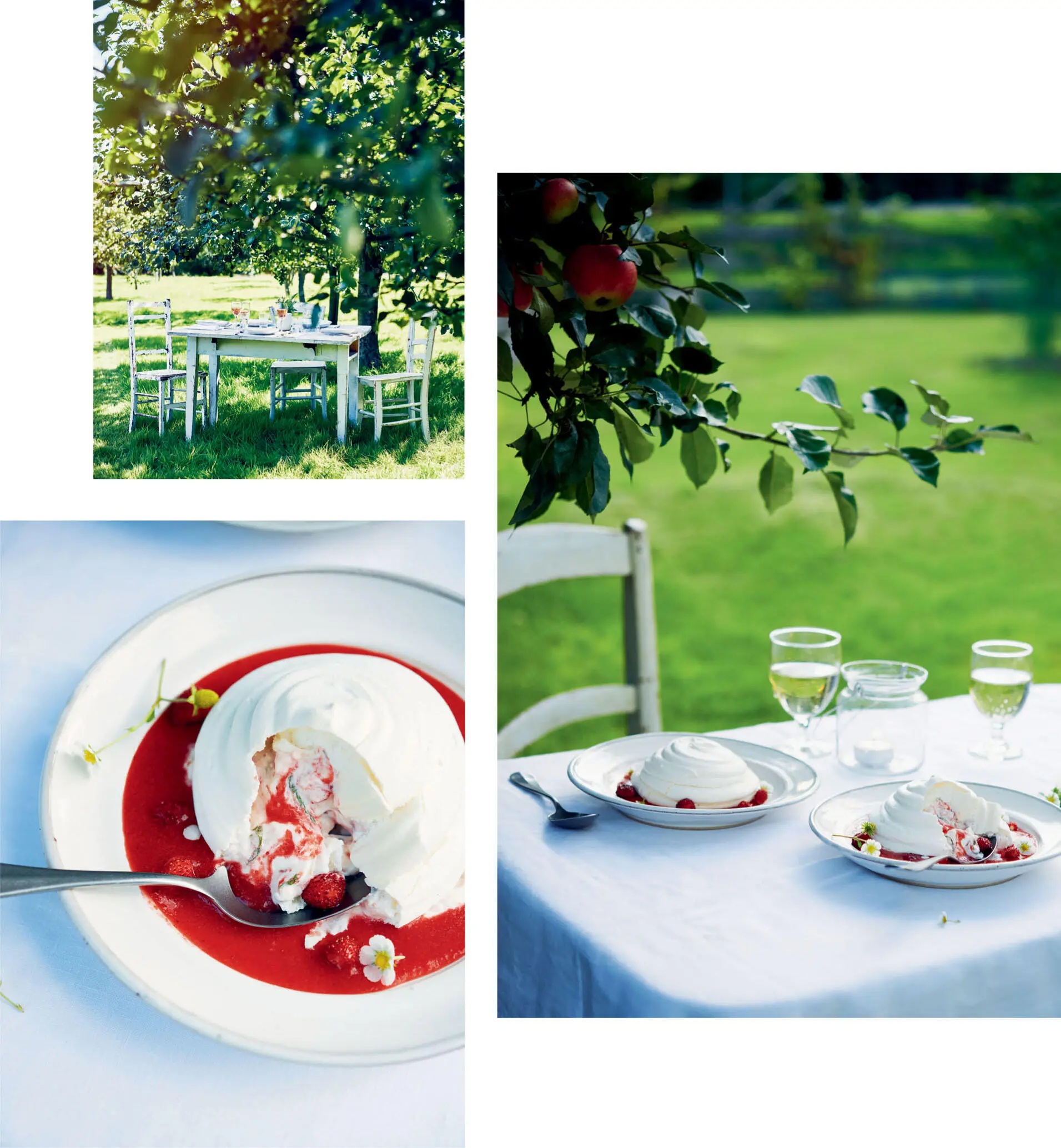4 Bake in the oven for 40–50 minutes until crisp on the outside, but still soft in the centre. Turn off the oven and leave the door ajar until the meringues are cool to touch. Very gently, scoop out the soft meringue with a spoon, leaving the shell intact. Set the soft meringue aside.
5 Take 200g of the strawberries and blend together with the vodka. Pass through a fine sieve. Chop the remaining 150g of strawberries and add to the soft meringue. Fold in the strawberry jam, whipped cream and finely sliced mint.
6 Divide the strawberry sauce between 4 bowls then carefully fill the meringue shells with the cream mix. Gently place a meringue in each bowl, on top of the sauce. Allow your guests to then make their own mess by smashing the meringue shell with their spoons!

Gooseberry and Basil Fool
When my dad was a young boy, gooseberries were one of his favourite fruits. Gooseberries tend to grow like weeds, and are a great fruit to just pick and pop in the freezer, whole, to save for a rainy and not so warm day. You can use frozen or tinned berries in this recipe, or try them in a crumble. The addition of basil in this recipe brings a slightly savoury note to the fool and creates an even richer floral aroma. You can make these fools up to a day ahead, if you wish.
SERVES: 4 | PREP TIME: 15 MINUTES | COOKING TIME: 30 MINUTES, PLUS SETTING
150g caster sugar
400g gooseberries, topped and tailed
200ml double cream
FOR THE CUSTARD
160ml milk
16 large basil leaves
2 egg yolks
1 tsp custard powder
30g demerara sugar
1 Put the caster sugar in a large saucepan. Add 200ml of warm water and bring to a simmer. Add the gooseberries and simmer gently for 5 minutes, then remove a fifth of the berries and set them aside. Keep cooking the remaining berries for about another 10 minutes until soft. Transfer to a blender or food processor and blitz until smooth.
2 To make the custard, put the milk and half of the basil leaves in a small saucepan and bring just to the boil, stirring frequently.
3 Put the egg yolks, custard powder and sugar in a heatproof bowl and whisk until well combined. Slowly pour in the hot milk mixture, whisking continuously. Return the mixture to the pan and cook over very low heat, stirring constantly, for about 5 minutes or until the custard coats the back of a wooden spoon (take care not to boil the custard as the egg yolks will scramble). Strain through a fine sieve into a clean container, cover the surface of the custard with clingfilm (to avoid a skin forming) and chill in the fridge.
4 Lightly whip the double cream.
5 Once the custard is cold, whisk it well then fold it into the lightly whipped cream. Fold in the gooseberry purée. Thinly slice the remaining basil leaves and fold them through the mix.
6 Divide the fool among 4 glasses. Halve the gooseberries you cooked and set aside, and arrange them on top of the fools. Place in the fridge for at least 1 hour, until set.
Caramelised Honey-roasted Pears with Mascarpone and Filo
One of the wonderful discoveries of Melfort Farm was the honey I inherited. The floral taste is quite remarkable and I found myself wanting to use it in a lot of my cooking. This discovery coincided with the pears ripening too, so it was a no-brainer to combine the two.
SERVES: 4 | PREP TIME: 20 MINUTES | COOKING TIME: ABOUT 30 MINUTES
8 tbsp runny honey
4 ripe (but not too soft) pears, peeled, quartered and cored
6 sprigs of thyme
20g butter, melted
pinch of sea salt
7 sheets of filo pastry
200g mascarpone
100ml double cream
25ml brandy
1 Preheat the oven to 210°C/190°C fan/gas 7.
2 Place the honey in a roasting tray just large enough to fit the pear quarters in a single layer (about 20 × 20cm). Put the dish in the oven for 5 minutes to warm the honey, then add the pear quarters and thyme and return to the oven for 15–20 minutes, until the pears are golden and cooked through. Remove from the oven, carefully lift out the pears and set them aside. Scrape the honey into a bowl, removing the thyme sprigs and set it aside, too.
3 Add 2 tablespoons of the baked honey to the melted butter in a bowl, along with the salt, and mix well.
4 Take one sheet of filo pastry and brush it with the honey butter. Repeat with the remaining sheets and lay them on top of each other. Cut the large rectangle into 8 equal squares and gently scrunch up the edges of each layered piece. Place them on a baking tray and bake for 8–10 minutes until golden and crisp.
5 In a large bowl, whisk the mascarpone until smooth. Add the double cream, brandy and 2 tablespoons of the baked honey and whisk together until stiff.
6 To serve, place 2 pastry pieces on each plate then add the baked pear quarters. Dollop with the mascarpone and drizzle over the remaining baked honey.
MARCUS’ TIP:
Filo pastry is a great ingredient to have on hand in the freezer. You can use it for a speedy pie in winter, or for a summer quiche.
Harvest Preservation
When you have an abundance of fruit or vegetables from the garden it is sometimes hard to know what to do with it all if it is too much to get through in your daily meals. Preserving is something we chefs do quite a lot. It’s wonderful coming across a little jar of wonder a month or two down the line when the fresh ingredient is no longer available. And preserved foods tend to just get better and better the longer you keep them. They look great on the kitchen shelves, too – just like a good cookbook. The methods of preservation below detail ways to ensure you can maximise the use, and enjoyment, of seasonal produce. It also means a lot less waste, and plenty to look forward to throughout the year.
For any form of preservation, you will need clean, sterilised glass jars, with clean lids. I find the best way to do this is place the clean jars in an oven, at 140°C/120°C fan/gas 1 for 10 minutes. Clean any non-ovenproof lids and rubber seals separately in hot soapy water, then rinse and dry. Remove the jars from the oven and allow to cool slightly before filling and sealing.
The recipes that follow are meant as guidelines so you can adapt them according to what you have a lot of, or flavours you enjoy. Garden herbs, spices and citrus peel are all great things to add to any of the recipes below.
FERMENTING
Fermentation is an age-old preservation method that has had somewhat of a resurgence of late. It’s a little more adventurous, and is something everyone should try. It’s good for your gut, too. A lot of items we consume daily are actually a product of fermentation, such as cheese and wine. Kimchi is Korean in origin and is a spicy, fermented cabbage. It is great to shred up and use in salads, on burgers, in frittatas and in toasted sandwiches.
Best for fermenting
Cabbage, Cauliflower leaves, Fennel, Lettuce, Kale
Fennel Kimchi
MAKES: AROUND 1KG | PREPARATION TIME: 20 MINUTES, PLUS 2 WEEKS’ FERMENTATION
2 garlic cloves, grated
15cm piece of fresh ginger, peeled and grated
1 tsp demerara sugar
2 tbsp gochujang paste
3 tbsp rice wine vinegar
1 tbsp table salt
3 fennel bulbs (about 900g), cut into 5mm-thick slices
1 Put all of the ingredients, apart from the fennel, in a blender or food processor. Blitz until well combined and a paste has formed.
2 Using gloves, massage the paste into the fennel for at least 4 minutes.
3 Pack the fennel kimchi into sterilised jars and seal with a lid. Leave to ferment at room temperature for at least 2 weeks before eating. The longer you leave it the more developed the flavour will become. To stop the fermentation, place in the fridge.
Читать дальше













